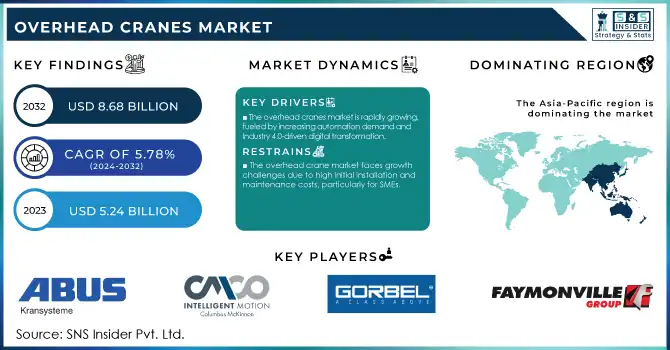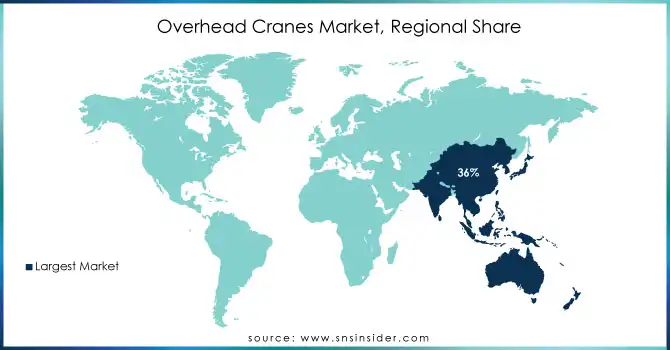Overhead Cranes Market Report Scope & Overview:
The Overhead Cranes Market size was valued at USD 5.54 Billion in 2024 and is expected to reach USD 8.69 Billion by 2032 and grow at a CAGR of 5.78% over the forecast period 2025-2032.
The Overhead Cranes Market has experienced substantial growth, driven by technological advancements, rising industrial demand, and increased automation in key sectors. Approximately 70% of cranes used in the market today are being integrated with IoT technologies and AI-driven systems to improve performance and maintenance scheduling, reducing downtime by up to 30%. The adoption of these smart systems is expected to grow as industries focus on predictive maintenance, energy savings, and overall efficiency. Electric overhead cranes are becoming increasingly popular, with a shift towards greener alternatives in line with stricter environmental regulations.

To Get More Information on Overhead Cranes Market - Request Sample Report
Demand for compact and lighter cranes has also surged, particularly in regions with high-density industrial setups. Companies are now focusing on reducing the size of cranes by utilizing advanced materials like aluminum and carbon fiber, which offer the same lifting capacity with a reduced structural weight. This trend has driven new design innovations that are expected to further revolutionize the market. Furthermore, overhead crane systems are increasingly being integrated with other material handling equipment, such as conveyor belts and automated guided vehicles (AGVs), to enhance workflow in warehouses and manufacturing plants. This integration is part of a broader move towards digitalization, with many large facilities investing in centralized control systems that can monitor and optimize crane performance in real-time.
Key Overhead Cranes Market Trends
-
Deployment of smart load-monitoring systems enabling real-time performance tracking and accident prevention.
-
Expansion of energy-efficient lifting solutions integrating regenerative drives for reduced operational costs.
-
Advancement in modular crane architectures facilitating flexible installation and easy scalability.
-
Increasing reliance on remote-controlled operations enhancing worker safety in hazardous zones.
-
Adoption of cloud-based fleet management platforms ensuring optimized scheduling and downtime reduction.
Overhead Cranes Market Growth Drivers:
-
The overhead cranes market is growing rapidly due to the rising demand for automation and smart technologies, driven by Industry 4.0 and digital transformation.
The overhead cranes market is experiencing significant growth driven by the increasing demand for automation and smart technologies, particularly with the rise of Industry 4.0 and digital transformation across industries. Automation technologies such as Internet of Things (IoT) sensors, AI-driven control systems, and predictive maintenance tools are revolutionizing crane operations by enhancing performance, reducing downtime, and optimizing workflow. These innovations enable industries to boost operational efficiency, improve safety, and minimize human intervention. Smart technologies allow cranes to adapt to changing environments, predict potential failures, and optimize load handling in real-time, further contributing to the rise in demand. As industries such as manufacturing, construction, and logistics adopt advanced solutions to meet the growing need for operational efficiency, overhead cranes with integrated smart technologies are becoming essential tools. Furthermore, the trend towards predictive maintenance is reducing long-term costs associated with repairs and unscheduled downtimes, adding to the appeal of technologically advanced cranes. This shift toward digitalized operations is not only enhancing productivity but is also helping industries achieve higher standards of precision and safety. Overall, the growing adoption of automation in manufacturing and material handling is fueling the expansion of the overhead cranes market, which is expected to continue growing as more sectors embrace smart, connected systems.
Overhead Cranes Market Restraints:
-
The overhead crane market faces growth challenges due to high initial installation and maintenance costs, particularly for SMEs.
The overhead crane market, while experiencing significant growth, faces a key restraint in the form of high initial installation and maintenance costs. These cranes are essential in industries such as manufacturing, construction, and logistics, but their adoption is hindered by the substantial upfront investment required for purchase, installation, and integration, especially for advanced models equipped with automation and smart features. For small and medium-sized enterprises (SMEs), this cost barrier can be prohibitive, limiting their ability to adopt these systems despite the potential productivity and efficiency benefits. Moreover, maintenance costs for these specialized cranes can be high, particularly for those used in heavy industries, which require frequent servicing and specialized parts. This ongoing expense further limits the affordability and accessibility of overhead cranes for many businesses. However, the market is seeing trends that aim to reduce these barriers, such as the development of cost-effective, modular crane systems, and advancements in predictive maintenance technology, which can reduce downtime and maintenance costs over time. Despite the initial financial challenges, the overhead crane market continues to grow, driven by technological innovations, increased automation, and the rising demand for efficient material handling solutions across industries.
Overhead Cranes Market Segment Analysis
By Type
Bridge cranes segment dominated with the market share over 37% in 2024, due to their high versatility and broad applications across various industries. They are designed to move heavy loads over large areas, making them ideal for complex lifting tasks in industries like construction, automotive, manufacturing, and shipping. The ability of bridge cranes to span vast workspaces and provide precise load handling boosts their demand, especially in heavy-duty environments. Their robust structure and high capacity for lifting heavy materials make them essential for operations requiring large-scale, efficient lifting solutions. Furthermore, the adaptability of bridge cranes in different industrial settings whether for lifting raw materials, assembling components, or loading goods further increases their popularity.
By Lifting Capacity
The Up to 5 Ton segment dominated with the market share over 42% in 2024, due to its widespread adoption across various industries. Cranes with a lifting capacity of up to 5 tons are commonly used in manufacturing, warehouses, and logistics, where they handle lighter loads and offer efficient lifting solutions for routine operations. These cranes are ideal for tasks such as material handling, assembly, and moving small equipment, making them essential in many sectors. The popularity of this segment is also driven by their cost-effectiveness, as they are less expensive to purchase, operate, and maintain compared to higher-capacity cranes. Furthermore, they cater to a broad range of applications, from small-scale manufacturing units to large distribution centers, offering versatility and ease of use.
Overhead Cranes Market Regional Outlook
Asia-Pacific Overhead Cranes Market Insights
Asia-Pacific region dominated with the market share over 36% in 2024. This dominance is driven by the rapid industrialization in countries like China, India, Japan, and South Korea, where manufacturing and construction sectors are flourishing. The region’s extensive infrastructure development, including the expansion of ports, logistics, and warehouses, has led to an increased demand for overhead cranes for efficient material handling and lifting operations. Additionally, the presence of key crane manufacturers in Asia-Pacific, coupled with affordable production costs, has made the region a major hub for both production and consumption.
North America Overhead Cranes Market Insights
North America is witnessing the fastest growth in the overhead cranes market, driven by the surge in industrial activities, including automotive manufacturing, aerospace, and construction. In the United States and Canada, key industries are increasingly adopting automated overhead cranes to improve efficiency and safety in material handling. With technological advancements in crane systems, such as smart sensors and IoT connectivity, North America is moving toward more sophisticated, energy-efficient solutions. The region is also experiencing a shift towards modernization and retrofitting of existing crane systems to enhance performance and reduce downtime.
Europe Overhead Cranes Market Insights
Europe’s overhead cranes market growth is propelled by strong automotive, aerospace, and heavy manufacturing sectors. Industrial automation, facility modernization, and retrofitting of outdated cranes are increasing adoption of advanced crane solutions. Countries such as Germany, France, and Italy focus on energy-efficient, durable, and IoT-enabled cranes to improve productivity, safety, and reduce downtime. Government initiatives supporting industrial innovation further enhance market opportunities. Additionally, increasing demand for specialized lifting solutions in ports, warehouses, and manufacturing plants strengthens the region’s position, creating substantial opportunities for domestic and international overhead crane manufacturers and suppliers.
Middle East & Africa Overhead Cranes Market Insights
The Middle East and Africa region experiences steady growth due to large-scale construction, mining, and oil & gas projects. Countries like Saudi Arabia, UAE, and South Africa are investing in industrial infrastructure requiring heavy-duty and reliable overhead cranes. The market benefits from government initiatives in energy, logistics, and industrial automation. Crane adoption focuses on high durability, load capacity, and safety, suitable for challenging environments. Expansion of ports, warehouses, and manufacturing facilities further drives demand. Both domestic and international manufacturers are leveraging these opportunities to supply advanced material handling equipment tailored for the region’s industrial and infrastructural requirements.
Latin America Overhead Cranes Market Insights
Latin America’s overhead cranes market is expanding steadily, with Brazil, Mexico, and Argentina leading industrial growth. Infrastructure investments, including ports, warehouses, and manufacturing plants, are boosting demand for efficient material handling solutions. Key industries such as automotive, construction, and mining are increasingly adopting cranes to enhance operational efficiency, productivity, and safety. Technological adoption, including semi-automated and automated crane systems, is gradually rising, while modernization and replacement of obsolete equipment create additional opportunities.

Do You Need any Customization Research on Overhead Cranes Market - Inquire Now
Overhead Cranes Market Companies:
-
GH Cranes & Components
-
Konecranes Plc
-
Jaso Industrial Cranes
-
Columbus McKinnon Corporation (CMCO)
-
EMH, Inc.
-
Gorbel Cranes
-
Kito Corporation
-
Ralf Teichmann GmbH
-
Sumitomo Heavy Industries Material Handling Systems Co., Ltd.
-
Terex Corporation
-
Liebherr Group
-
Sany Group
-
Cargotec Corporation
-
Dongqi Crane
-
DHS Crane
-
ZPMC (Shanghai Zhenhua Heavy Industries Co.)
-
Demag Cranes & Components
-
Faymonville
Competitive Landscape for Overhead Cranes Market:
Konecranes Oyj, founded in 1994, is headquartered in Hyvinkää, Finland. The company specializes in designing, manufacturing, and servicing cranes and lifting equipment, serving diverse sectors including manufacturing, automotive, steel, and paper industries. Konecranes operates globally, providing material handling solutions that enhance productivity and safety.
-
In August 2024: Konecranes unveiled the Konecranes X-series industrial crane, a successor to the popular CXT model. Featuring a compact design, advanced technology, and lifting capacities up to 20 tons, the X-series is designed to enhance industrial lifting with improved efficiency and operator experience, including wireless upgrades, ergonomic radio controls, and low headroom hoists, all while reducing environmental impact.
-
In September 2023: Engineered Material Handling (EMH) introduced a single-leg semi-gantry crane to optimize overhead crane usage. With a 10-ton capacity, its poly wheel design eliminates the need for floor rails, reducing costs and enhancing floor safety.
| Report Attributes | Details |
|---|---|
| Market Size in 2024 | USD 5.54 Billion |
| Market Size by 2032 | USD 8.69 Billion |
| CAGR | CAGR of 5.78% From 2025 to 2032 |
| Base Year | 2024 |
| Forecast Period | 2025-2032 |
| Historical Data | 2021-2023 |
| Report Scope & Coverage | Market Size, Segments Analysis, Competitive Landscape, Regional Analysis, DROC & SWOT Analysis, Forecast Outlook |
| Key Segments | • By Type (Gantry Cranes, Jib Cranes, Bridge Cranes, Others) • By Lifting Capacity (Up to 5 Ton, 6-10 Ton, 11-50 Ton, More Than 50 Ton) • By End Use Industry (Manufacturing, Automotive and Transportation, Construction, Metal and Mining, Power and Utilities, Ports and Shipyards, Others) |
| Regional Analysis/Coverage |
North America (US, Canada), Europe (Germany, France, UK, Italy, Spain, Poland, Russsia, Rest of Europe), Asia Pacific (China, India, Japan, South Korea, Australia, ASEAN Countries, Rest of Asia Pacific), Middle East & Africa (UAE, Saudi Arabia, Qatar, Egypt, South Africa, Rest of Middle East & Africa), Latin America (Brazil, Argentina, Mexico, Colombia Rest of Latin America) |
| Company Profiles | ABUS Kransysteme GmbH, Columbus McKinnon Corporation (CMCO), EMH, Inc., GH Cranes & Components, Gorbel Cranes, Kito Corporation, Konecranes Plc, Ralf Teichmann GmbH, Sumitomo Heavy Industries Material Handling Systems Co., Ltd., Weihua Group, Terex Corporation, Liebherr Group, Jaso Industrial Cranes, Sany Group, Cargotec Corporation, Dongqi Crane, DHS Crane, ZPMC (Shanghai Zhenhua Heavy Industries Co.), Demag Cranes & Components, Faymonville. |

